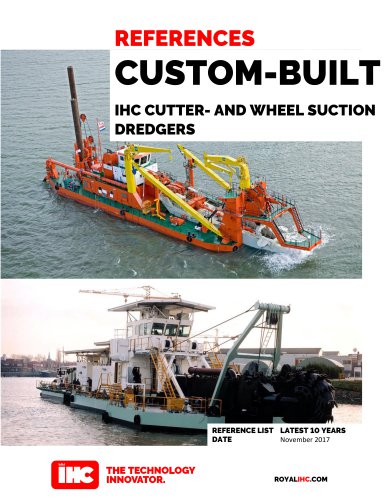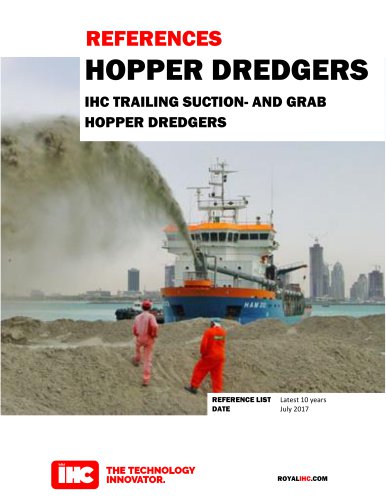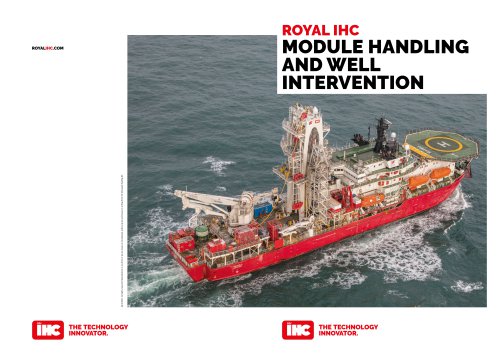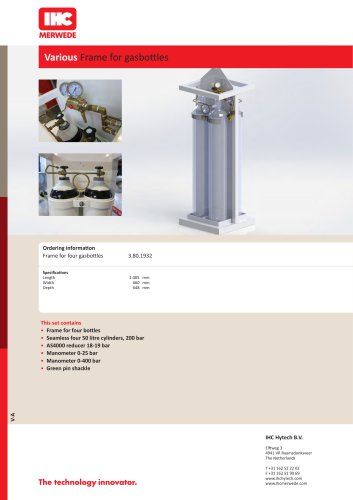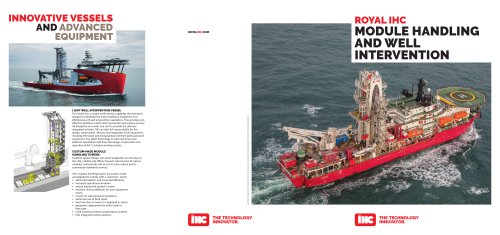
Excertos do catálogo

IHC Hytech is using umbilicals made of Elestollan 1185A Introduction The resistance of plastic materials against chemicals, solvents and other contact substances is an important criterion of selection for many applications. When contacting such substances the mechanical properties of plastic materials including Elestollan can be affected. This technical data sheet provides a survey in tabular form, of the behavior of selected Elastollan grades towards common contact substances. This survey is divided into various categories (e.g. weak acids, mineral acids, alkaline solutions, solvents). The aim is to simplify the selection of Elastollan types when deciding on their application suitability. Test Conditions: Test Specimens Standard S2 dumb-bells according to DIN 53 504, All test pieces pretempered for 20 h at 100CC. Test Temperature Reagents, 60&C; Solvents, 20'5C Test Criteria Reagents: the immersion time to cause a reduction in ten sile strength to 20 N/mm2. Solvents: reduction in tensile strength due to swelling after three weeks immersion. The resistance is indicated roughly In terms of days, weeks, months or years. According to agenerai rule of thumb, resistance may be extrapolated to double when reducing temperature by 10°C. and when increasing temperature by 10°C. to half. Tests were performed with the Elastollan grades S 85 A, C 85 A and 1185 A, " Swelling and solution are primarily affected by the number of hydrogen bonds effective between the linear molecular chains, which increases with hardness. From this, it can be derived that harder products suffer Jess swelling, and their chemical resistance is higher. Highly oolar substances may In part or completely break down the molecular interactions, resulting in severe swelling and in extreme cases complete dissolution of Elastollan materials.
Abrir o catálogo na página 1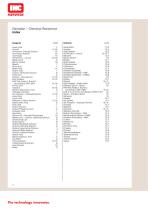
Reagents Code Ammonium Chloride Solution 10, Calcium Hydroxide Solution 9. Ethanol =■ Ethyl Alcohol 11 ./16. FAM Test Fluids A, B and C, according to DIN 51604 12./16. Diluted Hydrochloric Acid 4. Iso-Propanol = Isopropyl Alcohol 11716. Methanol = Methyl Alcohol 11716. Diluted Nitric Acid 6. Diluted Phosphoric Acid 3. Silicone Oil = Dimethyl Polysiloxane 14. Slaked Lime = Calcium Hydroxide Solution 9. Sodium Bisulphate Solution 3. Sodium Hydroxide Solution 9. Sodium Hypochlorite Solution 7 Sodium Nitrate Solution 7 Sodium Sulphite Solution...
Abrir o catálogo na página 2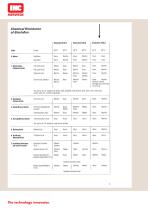
Chemical Resistance of Elastollan 1. Weak Acids, Carbonic Acids Tested Tap Water Sea Water 3% Acetic Acid 3% Lactic Acid 3% Boric Acid 3% Phenolic Solution Weeks Days Weeks Days Months Weeks Weeks/ Days Weeks Days Weeks Days Months/ Weeks/ Years Months Months/ Weeks Years Months However, tensile strength only 50% due to swelling The action of 3% solutions of formic acid, propionic acid, butyric acid, lauric acid, oleic acid, stearic acid etc., will be comparable. 2. Chelating Carbon Acids Months Days Months Days 3. Weak Mineral Acids 3% Sodium Bisulphate...
Abrir o catálogo na página 3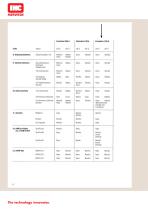
Elastollan 1185 A 8. Reducing Solutions Sodium Sulphite, 3% Months/ Weeks/ Years Months Saturated Calcium Hydroxide (Slaked Lime) 3% Soda Solution 3% Soda Lye (Caustic Soda) 3% Triethanolamine Solution Months/ Weeks Years Months/ Weeks Years Weeks Days Months Weeks Years Years Months Months/ Years 10. Basic Solutions 3% Urea Solution 3% Ammonium Solution 3% Ammonium Chloride Solution Months Weeks Days Months/ Years Hours Weeks/ Months Months/ Years Weeks Years Years Months Years Years Years Years Years Years Months Months Months Months Months Months Years Months Reduced...
Abrir o catálogo na página 4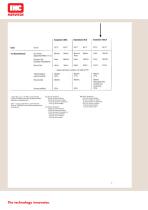
t Elastollan 1185 A 20°C 60°C 14. Miscellaneous Anti-freeze (Glysantine/Water 1/1.5) Silicone Fluid (Dimethyl Polysiloxane) Brake Fluid Trichloroethane volume swelling: Ethyl Acetate Volume swelling: ' DIN 51 604, part 3, 03.1984, is the standard, etablished by FAM to assess the resistance of plastic materials to automotive fuels. (FAM - FachausschuB Mineral- und Brennstoff-normung - Professional committee for standardization of fuel stuffs) Months Weeks Years Months Hours Hours Months/ Weeks Years Months Brake fluid/many hydraulic oils attack TPU Months 39% Months 65%...
Abrir o catálogo na página 5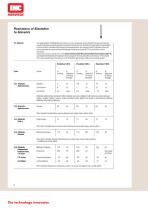
Resistance of Elastollan to Solvents >' 15. Solvents No degradation of Elastollan products occurs, however, according to the solvent class a variabledegree of swelling and consequent reduction in tensile strength (after evaporation ofthe solvents, thetensilestrength recovers approx, itsoriginal value). Methanol should be considered more as achemical reagent than as a solve ntITPU is soluble in some solvents. As test procedure, S2 dumb-bells were immersed in the solvent for three weeks at 20° C, and tested for tensile strength and residual swell 15 minutes after withdrawal. The values of...
Abrir o catálogo na página 6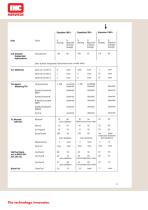
Swelling Reduction of Tensile Strength Swelling Reduction Swelling Reduction Other aromatic halogenated hydrocarbons have a similar affect. none none none none none 3 none 6 none none none none Tetrahydrofurane Dimethyl Formamide (DMF) Dimethyl Acetamide N-Methy! Pyrrolidone (NMP) Dimethyl Sulphoxide (DMSO) Pyridine practically dissolved dissolved dissolved dissolved dissolved dissolved practically dissolved dissolved dissolved dissolved dissolved dissolved dissolved dissolved dissolved dissolved dissolved dissolved FAM Test Fluids acc. to DIN 51 604 (ref, also 12.) Diesel Fuel...
Abrir o catálogo na página 7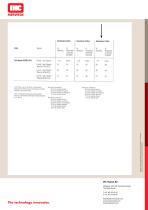
' DIN 51 004, pari 3, 03.1984, Is Hie standard, established by FAM [a assess Hit resistance ol plastic materials la automotive fuels. fFAM ^ FachausschuB Mineral- und Brennsrorr-norrnung —Professional comnillteetor sfnnuartJizaiinn of luel stulls) Test fluid A consists of; 50.0% by volume toluene 30.0% by volume Iso-octane 15.0% by volume di-lsobutylene 5.U% by volume ethanol Test fluid B consists of 42.0% by volume toluene 25.5% by volume iso-octane 13.0% by volume (D-teobutyierte 15,0% by volume methanol 4.5% by volume ethanol 0,5% by volume water rest fluid C consists ol. 20,0% by volume...
Abrir o catálogo na página 8Todos os catálogos e folhetos Royal IHC
-
CABLELAYING VESSEL
2 Páginas
-
SOV T38-14
2 Páginas
-
OLEG STRASHNOV Heavy lift vessel
2 Páginas
-
Toisa PEGASUS Diving support vessel
2 Páginas
-
DMC 1450
2 Páginas
-
SEVEN OCEANS
7 Páginas
-
Delta Multi Craft 1200
2 Páginas
-
REFERENCES Custom built
8 Páginas
-
IHC BEAVER® 30
2 Páginas
-
REFERENCES Hopper dredgers
11 Páginas
-
IHC Systems
8 Páginas
-
BOLD ENDEAVOUR
2 Páginas
-
SOVEREIGN
2 Páginas
-
TSHD IHC EASYDREDGE®
2 Páginas
-
TSHD IHC BEAGLE®
2 Páginas
-
IHC Beaver® 65 DDSP
2 Páginas
-
IHC Beaver® 50
2 Páginas
-
IHC Beaver® 45
2 Páginas
-
IHC Beaver® 40
2 Páginas
-
IHC Beaver® 300 SE
2 Páginas
-
Delta Multi Craft Workboat 1450
2 Páginas
-
Delta Multi Craft 1050
2 Páginas
-
OLEG STRASHNOV
2 Páginas
-
Diving support
9 Páginas
-
Pipelaying
8 Páginas
-
Seven Waves
3 Páginas
-
IHC Insight Pipelaying
19 Páginas
-
Sapura Diamante
6 Páginas
-
Diver hot water machine
2 Páginas
-
Double heat exchanger
2 Páginas
-
Single heat exchanger
2 Páginas
-
Hyperbreeze IV Scrubber
1 Páginas
-
Contamination canister
2 Páginas
-
CO2 Scrubber
2 Páginas
-
Scrubber/heater motor
2 Páginas
-
Umbilical storage
1 Páginas
-
Various Frame for gasbottles
1 Páginas
-
Spare air Filling unit
1 Páginas
-
QMS
2 Páginas
-
Mobile diver unit (MDU)
1 Páginas
-
flyer construction
2 Páginas
-
bro-d5-flyer_offshore
2 Páginas
-
IHC Metalix
2 Páginas
-
Subsea Seperator System
2 Páginas
-
Delta Escort Tug
2 Páginas
-
Hi-Traq
2 Páginas
-
T38-14
2 Páginas
-
SOV T60-18
2 Páginas
-
Mining Brochure
8 Páginas
-
Module Handling System
2 Páginas
-
Easydredge
2 Páginas
-
Offshore Brochure
10 Páginas
-
FPSO Brochure
2 Páginas
-
Pipelay Brochure
8 Páginas
-
Offshore Wind
4 Páginas
-
Beaver® 65
2 Páginas
-
Beaver® 50
2 Páginas
-
Beaver® 45
2 Páginas
-
Beaver® 40
2 Páginas
-
Dredging
10 Páginas
-
Corporate Profile
2 Páginas
-
Beaver Series
2 Páginas
-
IHC Beagle® 8
2 Páginas
-
IHC Beagle® 4
2 Páginas










